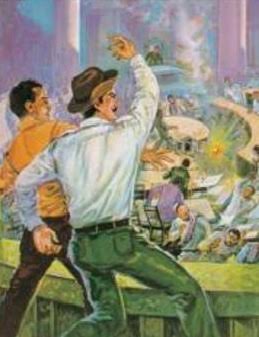One of India’s greatest revolutionary, Bhagat Singh, an
accidental freedom fighter, who initially only wanted to avenge the death of
his political leader, Lala Lajpat Rai, by killing the British General who
“Lathi Charged” Lala Lajpat Rai, the pride of Punjab, but went onto become a
name that every Indian resonates with.
The image of a mighty mustached man with a hat is how we
have been familiarized with one of India’s revolutionary freedom fighter,
Bhagat Singh.
What we haven’t been familiarized with, is his immense
contribution in our national struggle, and how he went onto etch his name in
the history of our nation.
The Central Assembly Bombing was his way of achieving
recognition, so that he could further his agenda of an independent India.
What happened in the Central Assembly Bomb
Case?
On 8th April, 1929, Bhagat Singh along with
his accomplice, Batukeshwar Dutt, hurled 2 bombs inside the proceedings of the
Central Assembly in New Delhi.
Their intentions were clear, they never intended to hurt
a single soul in the meeting, they just wanted to put across a message. The
message of an Independent India to all those Indians who had turned a deaf hear
to the nation’s cries.
Along with the bombs, copies of leaflets were also
dispersed in the air, they carried the slogan of “Inquilab Zindabad”
which meant “long live the revolution”
With Indians still supressed by the British Raj, the revolution
was the first of its kind without adequate backing from any clan.
The bombings rendered zero fatalities, as intended by
Bhagat Singh, but it did result in the arrest of Bhagat Singh, something that
he anticipated for a very long time.
The defiant act gave him a chance to get arrested and to
use subsequent court appearances to further the cause of his patriotism and
nationalism by way of the organization, Hindustan Socialist Republican
Association (HSRA).
Main reason behind the bombing
The bombing was aimed at creating dissent against the two
contentious bills, The Public Safety Bill and The Trade Dispute Bill.
The two bills were aimed at curtailing the already meagre
rights of the working class and put a ban against all strikes and termed them all
illegal or as an act of mutiny against the government, which could be leveraged
by the British to act upon their whims and fancies.
This bill was seen as an opportunity by the HSRA, to
raise their voice against imperialism.
Consequences for Bhagat Singh & B. Dutta
The two surrendered soon after the bombings, Bhagat Singh
was eventually awarded a death penalty and B. Dutta was sentenced to life
imprisonment.
Bhagat Singh’s arrest was the path to his plan perfectly
falling in place. He fought whilst he was in jail, he fought against the
inequality, racism, imperialism and mostly to instill a sense of patriotism and
nationalism amongst the people of India, mainly those who had no choice but to
comply with the unjust British Raj.
Bhagat Singh was deeply moved by the ill-treatment of the
political prisoners and went on what became the longest hunger strike in the history of India. The strike continued for 114 days.
Batukeshwar Dutta, was an accomplice, but he had nothing
to do with hurling the bombs at the assembly, yet he had vowed to stick with
Bhagat Singh through thick and thin, thus he assumed responsibility for one of
the two bombs, for which he received life imprisonment.
Bhagat Singh’s contribution to India’s
Freedom Struggle
Even while in jail, Bhagat Singh instilled a sense of
nationalism in every Indian through his novel slogans like “Inquilab Zindabad”,
“Workers of the World Unite”, and “Down with Imperialism”.
These slogans gained familiarity in every mass gathering
or political rally and was seen as strong instrument that held the faith of the
citizens.
One of the least spoken about revolts against the British Raj, but indeed one of the most effective revolts that remain etched in the history of our nation, which also widens our perception of Bhagat Singh, from only being a freedom fighter with a hat and a moustache, to being the mightiest warrior to have initiated the freedom struggle, without adequate backing at a time when Indian’s felt no choice but to remain under the dominance of the British.
Written By - Tushna Choksey










0 Comments